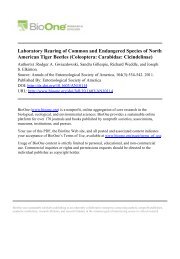Building Models from Experimental Data. - elkintonlab
Building Models from Experimental Data. - elkintonlab
Building Models from Experimental Data. - elkintonlab
You also want an ePaper? Increase the reach of your titles
YUMPU automatically turns print PDFs into web optimized ePapers that Google loves.
Pathogen-Driven Outbreaks Revisited 111<br />
so that newly hatched larvae have high relative susceptibility<br />
and/or pathogens produced in the epidemic have<br />
high overwinter survival. High values of the between-generation<br />
pathogen survival rate g, however, lead to stability<br />
because, when there is a consistently high density of pathogens,<br />
disease incidence is always high enough to cause at<br />
least a moderate epidemic, and the population never overshoots<br />
the disease threshold. Finally, host heterogeneity in<br />
susceptibility C is strongly stabilizing because, as figure 1<br />
shows, higher heterogeneity reduces the intensity of epidemics.<br />
As heterogeneity increases, each year’s epidemic<br />
therefore reduces the population to near the disease threshold<br />
rather than well below it, which eliminates the overshooting<br />
phenomenon responsible for fluctuations.<br />
The boundaries between stability and cycles are very<br />
similar for the short-epidemic model (not shown), and<br />
the discrepancy declines with increasing values of pathogen<br />
carryover f because high values of f lead to epidemics<br />
that rapidly burn out. For values of f ≥ 5, the boundary<br />
between stability and cycles for the short-epidemic model<br />
is indistinguishable <strong>from</strong> that of the infinite-epidemic<br />
model. An important difference between the two models,<br />
however, is that the model with short epidemics is more<br />
likely to show unstable cycles, for which the amplitude of<br />
the cycles becomes larger and larger over time. Indeed, as<br />
heterogeneity C is reduced, we eventually reach a value of<br />
C at which the short-epidemic model is apparently unstable<br />
(meaning that peak densities grow to unbounded<br />
values) for all values of l. In figure 4, we show the range<br />
of values of f and C for which the model is unstable<br />
irrespective of l, for different values of epidemic length<br />
T. Figure 4 thus shows that moderate levels of heterogeneity<br />
prevent unstable limit cycles in the short-epidemic<br />
2<br />
model, with C 1 1/2 being sufficient to guarantee stable<br />
cycles (the infinite-epidemic model also shows these dynamics<br />
but only for very low levels of heterogeneity). These<br />
effects occur because shorter epidemic periods exacerbate<br />
the overshooting phenomenon that leads to stable limit<br />
cycles in the first place, and the effect becomes stronger<br />
as the epidemic length is shortened. This sort of instability<br />
is of course unrealistic; in real populations some sort of<br />
density dependence will act to keep populations bounded.<br />
Nevertheless, figure 4 is interesting because it shows that<br />
moderate levels of heterogeneity can have a stabilizing effect<br />
on outbreak dynamics.<br />
Outbreaks in Defoliators: <strong>from</strong><br />
Experiments to Time Series<br />
In this section, we explore the consequences of our experimental<br />
estimates of heterogeneity C for gypsy moth<br />
population dynamics. Gypsy moth populations show moderate<br />
to high levels of heterogeneity in susceptibility<br />
Figure 4: Effects of epidemic length on model stability, demonstrating<br />
that host heterogeneity in susceptibility plays a key role in stabilizing<br />
cycles in the short-epidemic model.<br />
(Dwyer et al. 1997), and the model shows that high levels<br />
of heterogeneity are stabilizing, but gypsy moths in North<br />
America have unstable population dynamics (Williams<br />
and Leibhold 1995; Ostfeld et al. 1996). We therefore ask,<br />
Can our experimental data be reconciled with the unstable<br />
population dynamics of the gypsy moth In particular, is<br />
the heterogeneity in susceptibility that we observed in our<br />
experiments so high that it would lead to stable equilibrium<br />
gypsy moth densities rather than outbreaks Conversely,<br />
are the levels of heterogeneity in our data high<br />
enough to give stable cycles in the model, so that it is at<br />
least possible that populations are primarily regulated by<br />
disease alone<br />
An important preliminary question is, What constitutes<br />
outbreaking population dynamics We will use the popular<br />
criterion of large-amplitude fluctuations in population<br />
density (Mattson et al. 1991). In our model, for reasonable<br />
parameter values, large-amplitude fluctuations always occur<br />
in the form of long-period limit cycles. The statistical<br />
evidence for cyclicity in time series of outbreaking gypsy<br />
moth populations is mixed (Williams and Leibhold 1995),<br />
however, so we are implicitly assuming that in many cases<br />
the underlying cyclicity is obscured by environmental stochasticity.<br />
In future work, we will explore this point further.<br />
A second key point is that we define cycle period to<br />
be the number of generations between peaks of host density,<br />
rather than trying to calculate when or whether populations<br />
return exactly to previous values (a peak in density<br />
is defined to occur when a year’s density is higher than<br />
the preceding year’s and the following year’s densities).<br />
Clearly, the former definition is a more ecologically meaningful<br />
measure of cycle length. This kind of definition can<br />
be problematic with noisy or chaotic data; fortunately,



